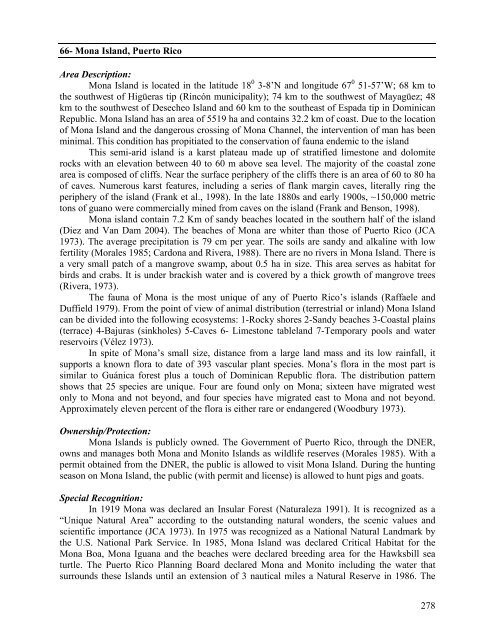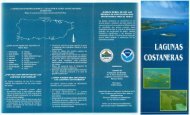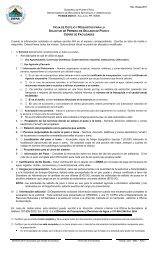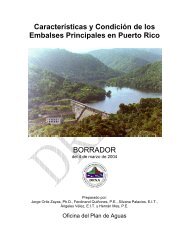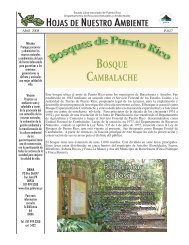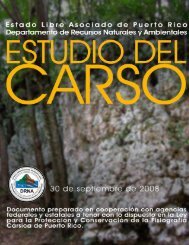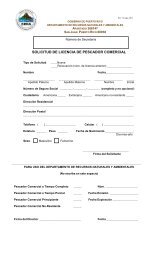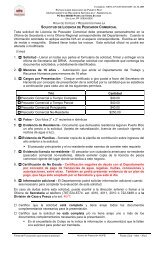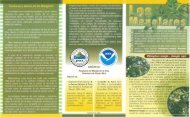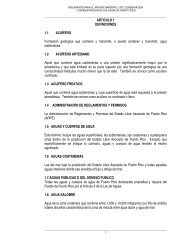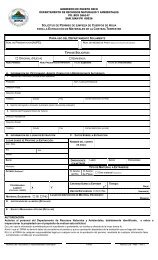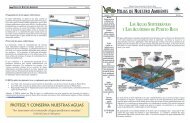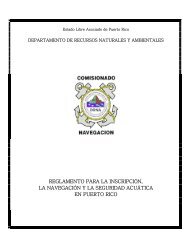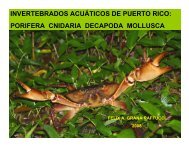Puerto Rico Critical Wildlife Areas - Puerto DRNA - Gobierno de ...
Puerto Rico Critical Wildlife Areas - Puerto DRNA - Gobierno de ...
Puerto Rico Critical Wildlife Areas - Puerto DRNA - Gobierno de ...
You also want an ePaper? Increase the reach of your titles
YUMPU automatically turns print PDFs into web optimized ePapers that Google loves.
66- Mona Island, <strong>Puerto</strong> <strong>Rico</strong><br />
Area Description:<br />
Mona Island is located in the latitu<strong>de</strong> 18 0 3-8’N and longitu<strong>de</strong> 67 0 51-57’W; 68 km to<br />
the southwest of Higüeras tip (Rincón municipality); 74 km to the southwest of Mayagüez; 48<br />
km to the southwest of Desecheo Island and 60 km to the southeast of Espada tip in Dominican<br />
Republic. Mona Island has an area of 5519 ha and contains 32.2 km of coast. Due to the location<br />
of Mona Island and the dangerous crossing of Mona Channel, the intervention of man has been<br />
minimal. This condition has propitiated to the conservation of fauna en<strong>de</strong>mic to the island<br />
This semi-arid island is a karst plateau ma<strong>de</strong> up of stratified limestone and dolomite<br />
rocks with an elevation between 40 to 60 m above sea level. The majority of the coastal zone<br />
area is composed of cliffs. Near the surface periphery of the cliffs there is an area of 60 to 80 ha<br />
of caves. Numerous karst features, including a series of flank margin caves, literally ring the<br />
periphery of the island (Frank et al., 1998). In the late 1880s and early 1900s, ~150,000 metric<br />
tons of guano were commercially mined from caves on the island (Frank and Benson, 1998).<br />
Mona island contain 7.2 Km of sandy beaches located in the southern half of the island<br />
(Diez and Van Dam 2004). The beaches of Mona are whiter than those of <strong>Puerto</strong> <strong>Rico</strong> (JCA<br />
1973). The average precipitation is 79 cm per year. The soils are sandy and alkaline with low<br />
fertility (Morales 1985; Cardona and Rivera, 1988). There are no rivers in Mona Island. There is<br />
a very small patch of a mangrove swamp, about 0.5 ha in size. This area serves as habitat for<br />
birds and crabs. It is un<strong>de</strong>r brackish water and is covered by a thick growth of mangrove trees<br />
(Rivera, 1973).<br />
The fauna of Mona is the most unique of any of <strong>Puerto</strong> <strong>Rico</strong>’s islands (Raffaele and<br />
Duffield 1979). From the point of view of animal distribution (terrestrial or inland) Mona Island<br />
can be divi<strong>de</strong>d into the following ecosystems: 1-Rocky shores 2-Sandy beaches 3-Coastal plains<br />
(terrace) 4-Bajuras (sinkholes) 5-Caves 6- Limestone tableland 7-Temporary pools and water<br />
reservoirs (Vélez 1973).<br />
In spite of Mona’s small size, distance from a large land mass and its low rainfall, it<br />
supports a known flora to date of 393 vascular plant species. Mona’s flora in the most part is<br />
similar to Guánica forest plus a touch of Dominican Republic flora. The distribution pattern<br />
shows that 25 species are unique. Four are found only on Mona; sixteen have migrated west<br />
only to Mona and not beyond, and four species have migrated east to Mona and not beyond.<br />
Approximately eleven percent of the flora is either rare or endangered (Woodbury 1973).<br />
Ownership/Protection:<br />
Mona Islands is publicly owned. The Government of <strong>Puerto</strong> <strong>Rico</strong>, through the DNER,<br />
owns and manages both Mona and Monito Islands as wildlife reserves (Morales 1985). With a<br />
permit obtained from the DNER, the public is allowed to visit Mona Island. During the hunting<br />
season on Mona Island, the public (with permit and license) is allowed to hunt pigs and goats.<br />
Special Recognition:<br />
In 1919 Mona was <strong>de</strong>clared an Insular Forest (Naturaleza 1991). It is recognized as a<br />
“Unique Natural Area” according to the outstanding natural won<strong>de</strong>rs, the scenic values and<br />
scientific importance (JCA 1973). In 1975 was recognized as a National Natural Landmark by<br />
the U.S. National Park Service. In 1985, Mona Island was <strong>de</strong>clared <strong>Critical</strong> Habitat for the<br />
Mona Boa, Mona Iguana and the beaches were <strong>de</strong>clared breeding area for the Hawksbill sea<br />
turtle. The <strong>Puerto</strong> <strong>Rico</strong> Planning Board <strong>de</strong>clared Mona and Monito including the water that<br />
surrounds these Islands until an extension of 3 nautical miles a Natural Reserve in 1986. The<br />
278


